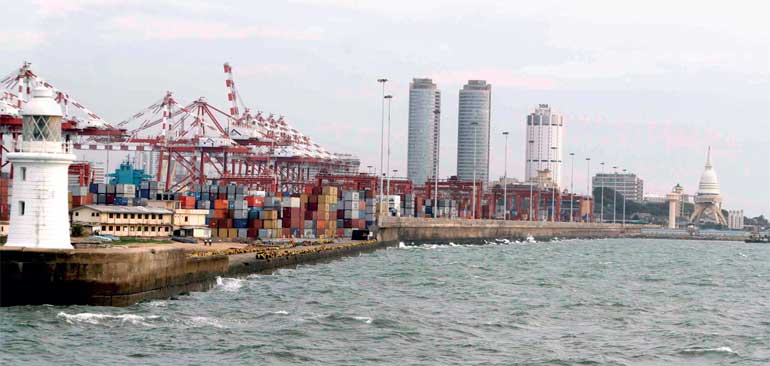Tuesday Dec 09, 2025
Tuesday Dec 09, 2025
Monday, 2 January 2017 00:16 - - {{hitsCtrl.values.hits}}

The forecast for the container volume throughput at the Port of Colombo for 2016 is approx. 5.6 million TEUS. The total capacity of the port of Colombo is approx. 7.2 million TEUS. The signs of the capacity tightening are already starting to show as seen in the daily operational issues at the port of Colombo.
The SLPA and SAGT Terminal have draft limitations and are only capable of handling vessels having drafts which are less than14.25 metres. Port of Colombo has only one deep draft terminal namely CICT with a depth of 18 metres and capacity of 2.4 million TEUS. The CICT’s berth occupancy rate is approximately 65% (weekly) and it will further increase with the arrival of the ultra large vessels after April 2017.
Port of Colombo deep draft terminal is unable to berth three 400M vessels, if three vessels arrive on the same day as their berth length is 1, 200 metres. This is a huge negative factor for major international shipping lines when considering if it is to move services to Colombo and considering using Colombo as a transshipment hub. The daily operating cost of an Ultra Large vessel is over $ 50,000 and keeping vessels waiting for a berth is not an attractive option for Shipping lines and will consider ports who have can provide them guaranteed berthing on arrival. Idling these vessels for the want of a berth creates significant losses to the shipping lines.
Development of regional ports with modern facilities will create major competition for the Port of Colombo in that these ports are going to attract vessels to call directly there. This will affect the transshipment volumes at the Port of Colombo as well as affect vessel calls at Colombo. (eg India – Sagara Mala Project / Develop existing 12 ports and are building five new deep draft ports – Vizhijam in Kerala and Colachel Tamilnadu ).
Even though the current berth occupancy rate at CICT is manageable, towards the weekends the berths are fully occupied. Shipping Lines will call at a port subject the berth being available on a specific day of the week and if the Terminals cannot provide the berth on the requested day, the lines need to look at alternative regional ports to berth their Mega vessels.
In this case, along with the main line service, feeder volumes also would divert to the regional ports. If this happens, there will be a significant impact for Port of Colombo as volumes of all 3 terminals would reduce with this development.
New regional ports will offer early bird/special discounts to attract volumes. Once volumes moved from Colombo to regional ports it is very difficult to bring back the same as lines would enter into long term partnerships with respective terminals of regional ports.
Delay in the construction and operation of the Eat Container Terminal (ECT) may result existing bidders dropping their decision to invest in Sri Lanka and to invest in other regional ports. This will result in container volumes shifting to regional ports along with the consortium volumes.
The delays in the bidding and decision making process of the SLPA/Government, as well as the sudden changing of terms and conditions after the bids have been closed, will drive away investors. Investors will ‘Think Twice’ for future SLPA/Government driven projects in the Port sector. This will severely affect the confidence of Investors in investing in Sri Lanka.
It is of paramount importance to expedite the East Container Terminal (ECT) development project.
Its three months since the closing of the bids for submitting EOIs for ECT and no decision has still been taken by the Cabinet Appointed Negotiating Committee (CANC) and the Government. CASA reliably understands that the Government is trying to introduce new conditions after the EOI bids have been closed which totally contradicts the initial conditions. These new conditions will eliminate all or most of the bidders which defeats the transparency and good governance processes.
The Ceylon Association of Shipping Agents who is the voice of the shipping industry in Sri Lanka wishes to stress on the importance of bringing ECT project on stream as soon as possible in a transparent manner, if Sri Lanka is serious about maintaining its transshipment shipping hub status and expanding its position to be the regional maritime hub.